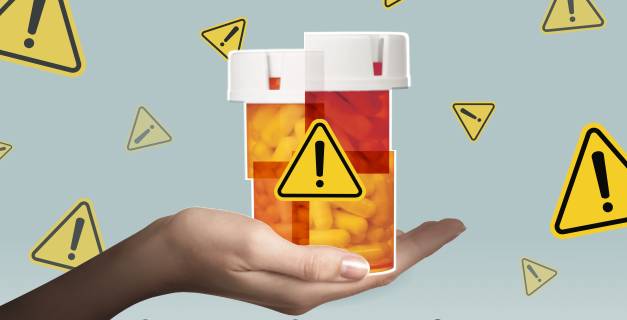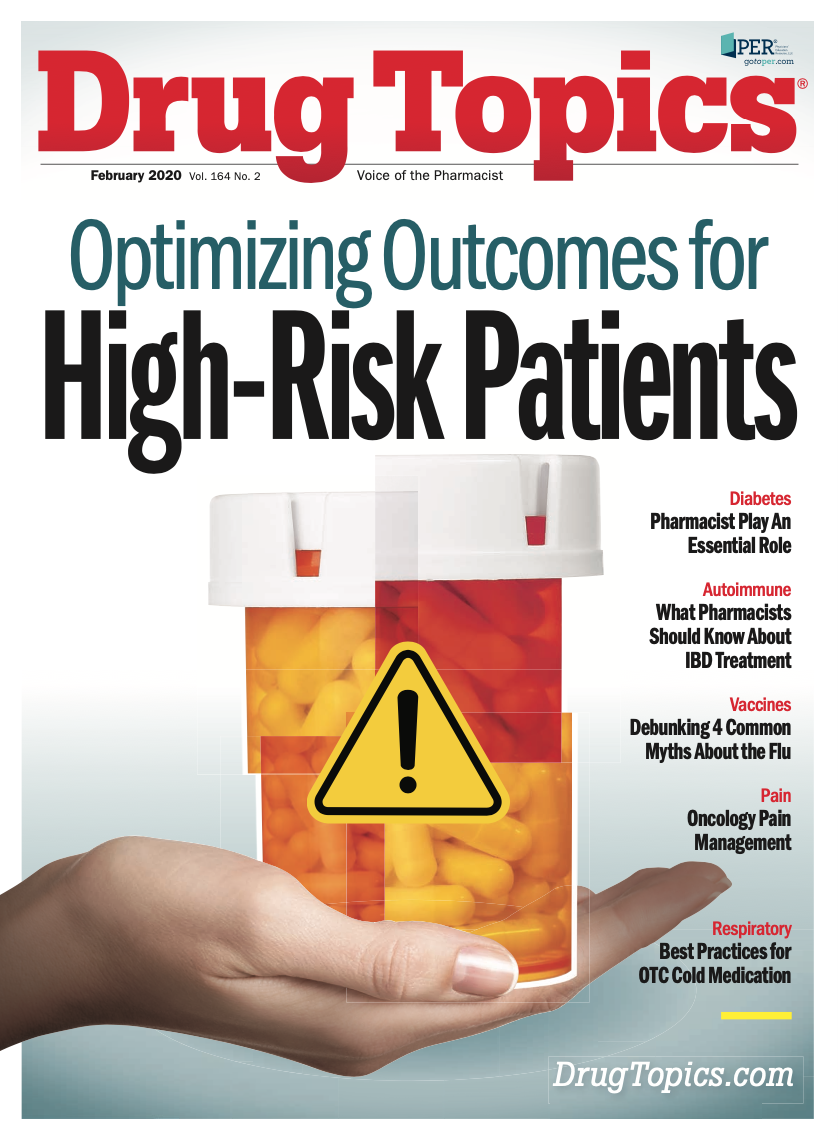Optimizing Outcomes for High-Risk Patients
Med Sync, collaborative care, and compensation for clinical services.

Patients with complex drug regimens for multiple disease states can be at high risk for a host of complications, including worsening disease, hospitalization, medication-related problems, and increased cost. Community pharmacists are ideally placed to manage these patients in a way that can positively impact their health outcomes.
“For disease state management, the pharmacist is the social worker that America never knew they had,” said Travis Wolff, PharmD, co-owner of Med-World Pharmacy in Sapulpa, Oklahoma. “Community pharmacists know the income level, they know the family situation, they know the patients by name, they know if they have transportation or delivery, they know so much about the patients and their lives beyond their drugs, and that knowledge is key.”
Syncing Up for Success
For high-risk patients with multiple prescriptions, med sync is essential, experts say. “You can catch so many med errors and improve so many chronic disease states with sync,” Wolff noted.
Not only does med sync simplify refilling prescriptions for patients, said Randy McDonough, PharmD, co-owner and director of clinical services of Towncrest Pharmacy in Iowa City, Iowa, but it also increases efficiency in the pharmacy and allows implementation of an appointment-based model. “When patients come to pick up their prescriptions we can sit down with them to make sure that we’re monitoring their medical conditions and medications appropriately and make any interventions we need to optimize their medications,” he explained.
Keeping track of complicated drug regimens can be overwhelming for patients, so compliance packaging can play a key role in improving adherence. At Towncrest Pharmacy, the most popular option for high-risk patients is what they call “Supersync,” single-dose packets of multiple pills packaged by a robotic dispensing system, Parata PASS. There are various options for user-friendly prescription packaging, McDonough said, but he cautions that labeling must comply with board of pharmacy regulations.
Holyoke Health Center, with locations in Holyoke and Chicopee, Massachusetts, is a federally qualified health center (FQHC) that serves an underserved, mainly Hispanic population. Its community pharmacy dispenses prescriptions to both health center patients and patients in the community and provides medication therapy management (MTM) for complicated patients. According to chief pharmacy officer Lori Lewicki, RPh, almost all of patients who receive MTM are dispensed their medications in a MedBox: a perforated card with bubble packs for 4 separate daily dosing times. To ensure patient comprehension, MedBoxes are labeled in English, Spanish, and with pictures, since 12% of their patients are illiterate. Med- Box use has been shown to significantly improve adherence and decrease overall medical costs.
With any packaging option, Wolff noted that good communication between the patient and pharmacist is essential, because otherwise, serious medication errors can occur if prescriptions are changed mid-month. McDonough explained that when necessary due to medication changes between refills, patients bring back all their medication packets to have them repacked with the correct new drug.
Counseling Points
Pharmacists counseling high risk patients must establish a good rapport with them, McDonough said, “because you’re going to be managing these patients in a different way, it’s more a case management where you’re going to be meeting with them on a regular basis.” Pharmacists should take the time to explain the patients’ conditions and how their medications are affecting the conditions, McDonough added. Motivational interviewing techniques are important, as are asking open-ended questions and identifying what knowledge the patients have and what must be filled in.
Although following practice guidelines is important, Wolff noted that his pharmacy has been successful with patients because “we meet them where they’re at.” He advises that after counseling, particularly regarding nonpharmacological lifestyle changes, the pharmacist should ask the patient, “Is any part of what I told you difficult for you to achieve?” In his diabetes education program, for instance, after reviewing dietary guidelines, pharmacists ask patients, “What are some of the foods you can never give up? What foods are important to your culture, your family?” They then adapt the advice to the patients’ lives, Wolff said, teaching them how to eat the foods they won’t give up in the appropriate quantities and how to adjust their diet elsewhere to compensate.
To effectively manage high-risk patients, pharmacists must understand and address their challenge. Lewicki stressed that pharmacists must consider patients’ health literacy and make sure to convey information in ways their patients can understand. Financial difficulties can pose a barrier to implementing nonpharmacological lifestyle management advice, said Marisa Piers-Gamble, clinical pharmacy coordinator at Holyoke Health Center. “It’s easy for us to tell them how to change their diet, but when they get home it’s a matter of how they can afford it,” she said.
Because many of Holyoke’s patients are Spanish speaking, community health workers (CHW) are a valuable pharmacy resource. In addition to teaching the staff key Spanish words and acting as interpreters for pharmacists during MTM visits and the immunization clinic, they conduct staff cultural competence training in which they explain how illnesses are viewed differently in their patients’ culture. CHWs reach out to patients a few days before their MedBox is set to refill to determine whether there have been changes to the patients’ therapy. MedBoxes are delivered for free; a new program will allow the delivery driver to bring an iPad with which patients with questions can connect to the pharmacist face-to-face. And to overcome transportation difficulties for patients who need to be seen in person at the clinic, Holyoke now uses Uber Health, Lewicki reported.
Collaborative Care
“With high-risk patients it’s important that you’re part of the team,” McDonough noted. High-risk patients often see multiple providers, so communication and coordination of care is vital. As pharmacists identify medication-related problems, they must submit those interventions to prescribers to ensure that patients’ drug therapy is optimized. “You have to do that over time,” McDonough explained. “Because these are complicated patients, we don’t make a lot of changes at one time.” He stressed building rapport with providers so they are more likely to accept clinical recommendations.
Wolff noted that not all prescribers are used to pharmacists taking an active role in managing patients’ therapy, so it’s important to demonstrate to them that “we’re actually there to help and not to be a threat to the doctor.”
The health care team need not include only physicians, physician’s assistants, and nurse practitioners, McDonough said. Pharmacists at Towncrest have recently begun collaborating with clinical pharmacists embedded in the cardiovascular and internal medicine clinics at the University of Iowa Hospital and Clinics. “There’s information they have that we don’t have and there’s information we have that they don’t normally have,” McDonough explained, “and we’ve found that by combining that information we’ve done a much better job at improving the therapy of our patients.”Inthefirst6months of this program, with 129 shared patients, pharmacists identified 45 patients with adherence issues, 30 patients with nonmatching medication lists, 15 patients with an incorrect dose, 11 patients who needed additional therapy, and 6 patients with a wrong medication.
Holyoke’s pharmacy is completely integrated into the health center, so pharmacists share information and work closely with the other health care professionals. Providers appreciate that pharmacists keep medication lists updated, and during hospital discharge follow-ups, pharmacists review the patients’ med lists with them before they are seen by other providers, Lewicki reported. Piers-Gamble is involved in a collaborative drug therapy management program where she has full prescriptive authority for hypertension. “We’ve seen clinically significant improvements in the patients who are enrolled in the program because they’re able to have such close monitoring of these specific disease states,” she said.
Compensation for Clinical Services
Holyoke Health Center is funded through a Health Resources and Services Administration (HRSA) 330 grant and is part of a Massachusetts accountable care organization (ACO) that focuses on the total cost of care (TCOC). “If we can decrease the TCOC, we can increase our shared savings from the state,” Lewicki explained. The ACO identifies high-risk patients and reimburses Holyoke accordingly for their care.
For typical community pharmacies, obtaining reimbursement for patient management is not simple, but it is possible. Although many high-risk patients are eligible for MTM through Medicare, “that doesn’t mean the MTM model fits best for these patients,” McDonough asserted, since Medicare reimburses pharmacists for only a once-a-year visit. “If you’re going to do a good job managing these high-risk patients you have to see them much more frequently,” he said. In a pilot study with a major Iowa payer, Towncrest demonstrated that their comprehensive case management for high-risk patients reduced overall health care costs by $300 per patient per month, an incentive for payers to compensate for these services.
Wolff has contracted with local physicians to perform services such as annual care visits in the physician’s office and chronic care management, which requires 20 minutes of phone counseling each month. Transitions of care is another opportunity to get reimbursed for helping high-risk patients, he said. Primary-care physicians are well compensated by Medicare for post-discharge visits within 7 days for complicated patients and 14 days for uncomplicated patients, he said, but they are required to complete a medication reconciliation within 48 hours after discharge. “A lot of physicians don’t know when their patients have been in the hospital, and they don’t find out until after that 48-hour window,” Wolff explained. “But where does the patient go when they leave the hospital? To the pharmacy to fill their meds!” Pharmacists can contract with physicians to perform medication reconciliations, record them in the physician’s electronic health record, and let the office know to schedule an appointment with the patient. “Since they know they don’t get paid at all unless you do that, they’re pretty willing to pay you,” he said.
Pharmacies can offer other services that can be valuable to high-risk patients. Wolff advises pharmacists to look at their patient demographics before choosing appropriate services to offer, such as diabetes education classes (which he feels are most profitable), smoking cessation classes, or COPD or asthma action plans. McDonough noted that, depending on state laws, pharmacists may be able to perform services such as blood pressure monitoring, lipid management, or glucose or hemoglobin A1c monitoring.
Establishing new revenue models to reimburse pharmacists appropriately for the care they provide high-risk patients is crucial, McDonough concluded. “These are patients that we’re trying to keep from being very catastrophic, very high cost... so we need to be paid more appropriately.”
